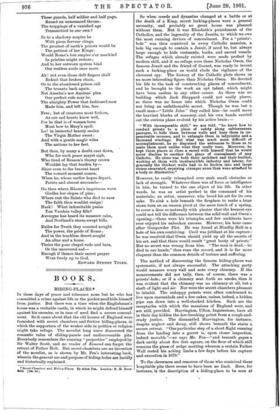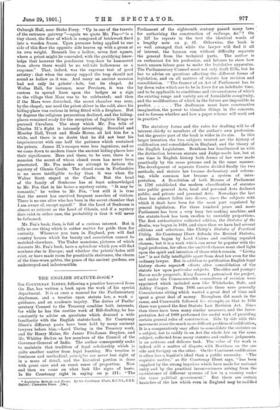BOOKS.
HIDING-PLACES.*
IN these days of peace and tolerance none but he who has committed a crime against life or the pocket need hide himself from justice. But there was a time when the Englishman's house was a veritable castle, in which he might defend himself against his enemies, or in case of need find a secure conceal- ment. So it came about that the old houses of England were furnished with secret chambers and furtive hiding-places, in which the supporters of the weaker side in politics or religion might take refuge. The novelist long since discovered the romantic value of sliding-panels and undiscoverable pits. Everybody remembers the cunning "properties" employed by Sir Walter Scott, and no reader of _Esmond can forget the retreat of Father Holt. But secret chambers are no invention of the novelist, as is shown by Mr. Pea's interesting book, wherein the general use and purpose of hiding-holes are lucidly and historically explained.
• Secret Chambers and Riding-Plaess. By Allan Pea. London: 8. H. Bona- 1114. [1(1. 64.1
So when creeds and dynasties changed at a battle or at the death of a King, secret lurking-places were a general necessity, and probably no great house was planned without them. But it was Elizabeth's punishment of the Catholics, and the ingenuity of the Jesuits, to which we owe the most cunning devices of concealment. For a " priests% hole " was then contrived in every Catholic mansion, a hole big enough to contain a Jesuit, if need be, but always large enough to hide vestments, books, and sacred vessels.
The refuges which already existed were made perfect by modern skill, and if no refuge were there Nicholas Owen, the famous Jesuit and the friend of Garnet, was ready to invent such a lurking-place as would elude the vigilance of the cleverest spy. The history of the Catholic plots shows us no more interesting figure than Nicholas Owen. He devoted his life to the task of constructing places of concealment, and be brought to the work an apt talent, which might have been useless in any other career. As there was no building which Jack Sheppard could not easily pierce, so there was no house into which Nicholas Owen could not bring an unfathomable secret. Though he was but a, small man—" Little John" they called him—he could move the heaviest blocks of masonry, and his own hands carried out the curious plans evolved by his active brain :— " With incomparable skill," we are told, "he knew how to conduct priests to a place of safety along subterranean passages, to hide them between walls and bury them in im- penetrable recesses, and to entangle them in labyrinths and a thousand windings. But what was much more difficult of accomplishment, he so disguised the entrances to these as to make them most unlike what they really were. Moreover, he kept these places so close a secret with himself that he would never disclose to another the place of concealment of any Catholic. He alone was both their architect and their builder, working at them with inexhaustible industry and labour, for generally the thickest walls had to be broken into and large stones excavated, requiring stronger arms than were attached to a body so diminutive."
However, he easily triumphed over such small obstacles as lack of strength. Whatever there was of force or intelligence in him, he turned to the one object of his life. In other words, he was an artist perfect in the command of his materials; an artist, moreover, who loved his art for its own sake. To sink a hole beneath the fireplace, to make a huge
stone turn on an unseen pivot at the mere touch of a spring, to cover a door so naturally with plaster that the keenest eye could not tell the difference between the solid wall and Owens opening,—these were his triumphs, and few architects have ever enjoyed his unbroken success. However, his hour came after Gunpowder Plot. He was found at Hindlip Hall in a hole of his own contriving. Cecil was jubilant at his capture ; he was resolved that Owen should yield up all the secrets of his art, and that there would result "great booty of priests." But no secret was wrung from him. "The man is dead,—he died in our hands," thus runs the record, and it is far more eloquent than the common details of torture and suffering.
The method of discovering the famous hiding-places was systematic, if not always successful. The attacking party would measure every wall and note every chimney. If the measurements did not tally, then, of course, there was a priests'-hole; or if a chimney sent forth no smoke, then it was evident that the chimney was no chimney at all, but a shaft of light and air. Nor were the secret chambers pleasant to inhabit. The unhappy priests were often condemned to live upon marmalade and a few cakes, unless, indeed, a hidden
pipe ran down into a well-stocked kitchen. Such are the receptacles with which the mansions of England were, and are still, provided. Harvington, Ufton, Ingatestone, have all in their day hidden the law-breaking priest from a rough-and- ready justice. The dismantled Harvington, for instance, despite neglect and decay, still shows beneath the stairs a, secure retreat. "One particular step of a short flight running from the landing into a garret is, upon closer inspection, indeed movable "—so says Mr. Fea—" and beneath gapes a dark cavity about five feet square, on the floor of which still remains the piece of sedge matting whereon a certain Father Wall rested his aching limbs a few days before his capture and execution in 1679."
To the cleverness and resource of those who contrived these hospitable pita there seems to have been no limit. Here, for instance, is the description of a hiding-place to be seen at
Oxburgh Hall, near Stoke Ferry. "Up in one of the turrets of the entrance gateway "—again we quote Mr. Pea—" is a tiny closet, the floor of which is composed of brickwork fixed into a wooden frame. Upon pressure being applied to one side of this floor the opposite side heaves up with a groan at its own weight. Beneath lies a hollow, seven feet square, where a priest might lie concealed, with the gratifying know- ledge that however the ponderous trap-door be hammered from above there would be no tell-tale hollowness as a response." That, indeed, was the supreme test of good artistry : that when the enemy rapped the trap should not sound as hollow as it was. And many an ancient mansion had not only its priests' - hole, but its chapel At Wollas Hall, for instance, near Pershore, it was the custom to spread linen upon the hedges as a sign to the village that Mass was to be celebrated; and then if the Mass were disturbed, the secret chamber was near, by the chapel; nor need the priest shiver in the cold, since his hiding-place was curious in being fitted with a fireplace. But by degrees the religious persecution declined, and the hiding- places remained ready for the reception of fugitive Kings or pursued Cavaliers. The story which Mr. Pea tells of Charles IL's flight is intensely interesting. Boscobel and Moseley Hall, Trent and Heale House, all hid him for a while, and there is no doubt that he did not bear his imprisonment with one half the patience which sustained the priests. James IL's escapes were less ingenious, and as we come down to modern times the ancient hiding-places lose their significance. Here and there, to be sure, there is a mansion the secret of whose closed room has never been penetrated. Mr. Fea makes no attempt to fathom the mystery of Glamis Castle. The closed room in Forfarshire is no more intelligible to-day than it was when Sir Walter Scott stayed at the Castle. But the head of the family of Senhouse has at least acknowledged to Mr. Pea that in his house a mystery exists. "It may be romantic," he writes to Mr. Pea, "but still it is true that the secret has survived frequent searches of visitors. There is no one alive who has been in the secret chamber that I am aware of, except myself." But the Lord of Senhouse is almost as reticent as the Lord of Glamis, and if a mystery does exist in either case, the probability is that it will never be fathomed.
Mr. Pea's book, then, is full of a curious interest. But it tells us one thing which is rather matter for pride than for curiosity. Wherever you turn in England, you will find country houses which for beauty and association cannot be matched elsewhere. The Tudor mansions, pictures of which decorate Mr. Fea's book, have a splendour which you will find nowhere else in' Europe; and whether the priests'-holes still exist, or have made room for practicable staircases, the charm of the time-worn gables, the peace of the ancient gardens, are undestroyed and indestructible.





















































 Previous page
Previous page